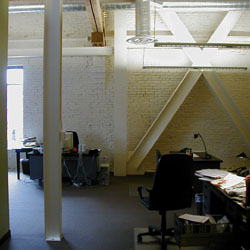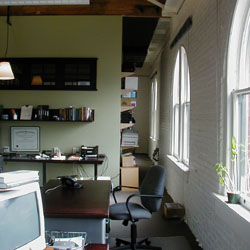|
|||||
|
|
|
||||
Utilize Available Daylight as much as PossibleCarefully examine the decision to locate the enclosed, opaque conference room volume in a prime area of the daylit zone. Moving this volume away from the South wall (perhaps to the East wall) provides three benefits: 1) it frees up a large area of daylit floor space that is currently wasted; 2) it allows daylight to penetrate penetration further into the room, and 3) it increases the overall brightness of surfaces in the office, which makes the entire space feel brighter. Increase Daylight Distribution/PenetrationExtend the skylight: Clearly this is the single most effective modification to the daylighting strategy for the space. If done in conjunction with moving the conference volume, the increase in perceptual brightness is especially improved. Increase Energy-Efficiency of Electric LightingMake more efficient use of existing energy - get fixtures that direct light downward, or hang light-reflecting baffles over lights to reflect light toward task surface. We anticipate that this change will provide a significant increase in incident ambient electric light levels. It may even turn out to be overlighting the space, which would mean that energy use could be reduced. Concept of Daylight / Electric ZonesOur exploration of daylighting redesigns reveals the difficulty of
daylighting the portions of this office space that are further from
the windows. It would be more appropriate to implement the concept of
two lighting zones - one primarily daylit, one primarily electrically
lit. Peripheral spaces near walls with windows can rely primarily on
daylight for task surface illumination. The remainder of the space would
rely on electric lighting, preferably a configuration that performs
more efficiently than the existing electric lighting.
|
|||||
|
|
|
||||
|
|||||
|
|
|||||

